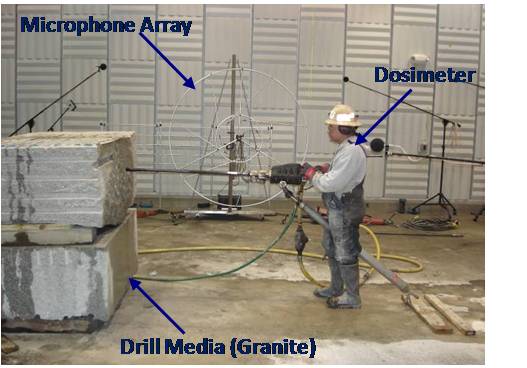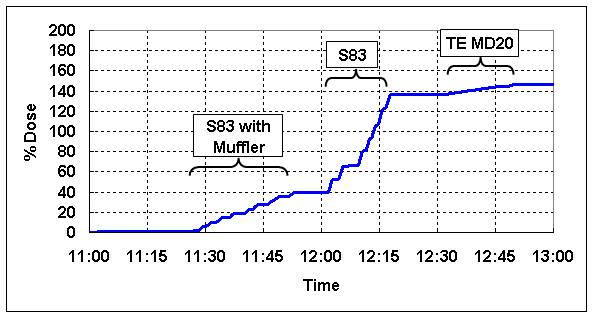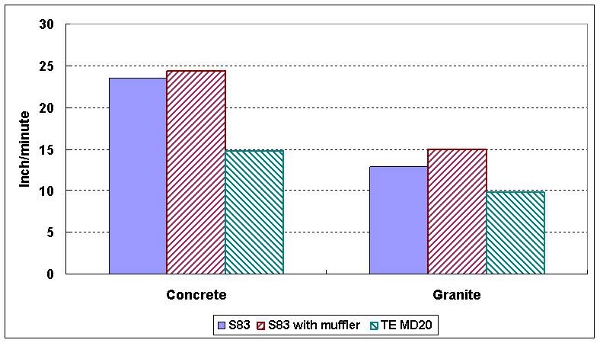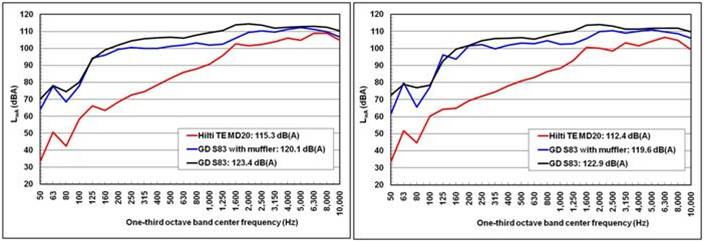Acoustic Comparison of Pneumatic and
Electric Jackleg Drills Used in the Mining Industry
Hugo E. Camargo - HCamargo@cdc.gov
Jeffrey S.
Peterson - JPeterson@cdc.gov
Peter G.
Kovalchik - PKovalchik@cdc.gov
Lynn A. Alcorn -
lyn3@cdc.gov
National
Institute for Occupational Safety and Health
Popular version
of paper 3aNCc2
Presented on
Wednesday morning, April 21
159th
ASA Meeting, Baltimore, Maryland.
Disclaimer: The findings and conclusions in this article are those of the author(s)
and do not necessarily represent the views of the National Institute for
Occupational Safety and Health.
A study of U.S. western hard-rock miners noise exposure revealed that
96% of mining machine operators are exposed to noise levels exceeding the Permissible
Exposure Level (PEL), with jackleg drill
operators having the most rapid noise dose accumulation rate1. Jackleg
drills, simply referred to as drills throughout this article, are used to
drill blast holes that are filled with explosives. They are also used to drill
bolt holes, through which bolts are driven for roof support, especially in
narrow situations. Traditionally, these drills have been driven by pneumatic
power, i.e. compressed air. However, there are drills currently available that
are powered by electricity. These electric drills are less noisy and have lower
vibration levels than pneumatic drills, and constitute an attractive alternative
to pneumatic drills. However, electric drills also have lower penetration rates
than pneumatic drills2. As a consequence, the reduced noise of the
electric drills tends to be overshadowed by the slower penetration rates. One
of the outstanding issues to be addressed is to quantify the noise exposure reduction
benefits of the electric drills, so that their value can be assessed by mine
operators.
In this context, the
National Institute for Occupational Safety and Health (NIOSH) conducted a study
to assess the acoustic performance of pneumatic drills and electric drills used
in the mining industry. The objective of
the study was to determine, from an occupational noise exposure perspective, whether
electric drills constitute a viable alternative to pneumatic drills. This
article presents the most relevant results from the study. A more comprehensive
report can be found in Reference 3.

(a)
Pneumatic drill. (b)
Pneumatic drill with muffler. (c)
Electric drill.
Figure 1. Drills under test.

Figure 2. Experimental setup for noise source identification
measurements.
3 RESULTS
3.1 Noise Source
Identification
Noise source
identification was conducted to determine the physical location and the
frequency content of the dominant drill noise sources. To accomplish these tasks,
a microphone array was used to measure the acoustic field. The data were then
processed using a beamforming algorithm. This algorithm focuses the array to a
particular point in space where it is suspected a noise source is located. The
results from this processing are acoustic maps in one-third octave frequency bands.
Figure 3 shows typical beamforming
acoustic maps. From these maps it can be observed that for the pneumatic drill
without muffler, the dominant noise source is located at the drill body. When a
muffler is installed, the sound is reduced by approximately 5 dB and now two
noise sources are present; one at the drill body and one at the
drill-steel-rock interaction place. Therefore, the muffler reduces the source
at the drill to a level that is comparable to the noise source at the drill
bit-rock interaction place. When the electric drill is used, it can be seen
that the sound is further reduced by approximately 9 dB, and now the dominant
source is located at the drill-steel-rock interaction place.

(a) Pneumatic drill. (b)
Pneumatic drill with muffler. (c) Electric drill.
Figure
3. Typical acoustic maps for
the tested drills (2000 Hz).
3.2 Noise Dose Accumulation
The cumulative dose was
measured using a dosimeter placed at the operators shoulder, as shown in
Figure 2. Figure 4 shows the cumulative dose as a function of time
while drilling into concrete. In this figure, the three segments corresponding
to the dose accumulated while operating each tested drill are clearly
identified. From this figure, it can be seen that the operator accumulates dose
more rapidly while operating the pneumatic drill. These results were used to
estimate average cumulative dose rates per minute which are summarized in Table
1.

Figure 4. Cumulative dose for the three tested drills while
drilling in Concrete.

Table 1. Operator cumulative noise dose.
3.3 Penetration Rate
The penetration rate was determined
by dividing the hole depth by the time required to drill a particular hole. The
penetration rate of the electric drill, as shown in Figure 5, is approximately 60%
the penetration rate of the pneumatic drill. Using these penetration rates, and
the cumulative dose, presented in Table 1, allows estimating the time required
to drill a reference 1.2 meter (48 inch) hole. It would take 1.98 minutes to
drill a reference hole in concrete using the S83 with muffler as opposed to
3.24 minutes using the TE MD20. Similarly, it would take 3.22 minutes to
complete a 1.2 meter (48-inch) reference hole in granite using the S83 with
muffler, while it would require 4.89 minutes to drill the same hole using the
TE MD20 drill. During this time, the operator of the pneumatic drill with
muffler would accumulate approximately 8.1% dose, while the operator of the
electric drill would accumulate 4.2% of the maximum allowable dose.

Figure 5. Penetration rate.
3.4 Determination of Sound Power Levels
The sound power level is the actual sound energy emission of a device.
Thus, it is a valuable tool for comparing the noise generated by the drills under
test. The sound power level radiated by the tested drills while drilling into
granite is presented in Figure 6a. Similarly, Figure 6b shows the sound power
level radiated by the drills while drilling into concrete. Figure 6a reveals
that the difference in sound power level between the pneumatic drill without
muffler and the electric drill is 10.5 dB(A). When the muffler is
installed, the difference in sound power level between the pneumatic drill
(with muffler) and the electric drill is reduced to 7.2 dB(A). Figure 6b shows a similar trend when
drilling into concrete. The difference in sound power level between the pneumatic
drill without muffler and the electric drill is 8.1 dB(A). When the muffler is installed, the difference between the
pneumatic drill (with muffler) and the electric drill is 4.8 dB(A).

(a)
Granite.
(b) Concrete.
Figure 6. Sound power level radiated by the drills.
A comparison between a
pneumatic drill and an electric drill was conducted by NIOSH. The results from
the various tests conducted in the study indicate that from an occupational noise exposure perspective, the acoustic performance of the electric
drill, despite its slower penetration rates, overcomes the acoustic performance
of traditional pneumatic drills. These findings provide quantitative
information to assist the mine operator in balancing potential miner hearing
loss and productivity with a viable means to meet regulations.
5 ACKNOWLEDGMENTS
The authors would like to thank Gary Roberts, Ron Key, and Rusty Lynn
Howard for providing the drills, and to Patrick McElhinney for his support for
setting up the test.
6 REFERENCES
3. Camargo, H.E., Peterson, J.S., Kovalchik,
P.G., and Alcorn, L.A., Acoustic Assessment of Pneumatic and Electric Jackleg
Drills Used in the Mining Industry, Proceedings of NoiseCon 2010, Baltimore,
MD, April19-21, 2010.